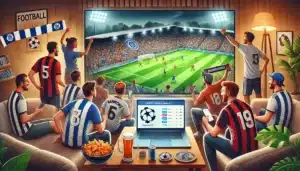Rise and Fall of TikTok Prankster Mizzy: A Tale of Fame, Controversy, and Legal Repercussions
In recent news, the world of social media was jolted by the sentencing of TikTok prankster Mizzy, real name Bacari-Bronze O’Garro. Known for his controversial antics on the platform, O’Garro has been handed an 18-week sentence for breaching a court order prohibiting footage sharing without consent. This case marks a significant moment in the ongoing discourse about the limits of humor and privacy in the digital age.
Mizzy’s journey to internet infamy began like many others through the allure of TikTok’s vast audience and the platform’s unique ability to catapult everyday individuals into the limelight. Initially playful and light-hearted, his content gradually veered into more daring territory. As his follower count swelled, so did the boldness of his pranks. This escalation was not unique to Mizzy; it mirrored a broader trend on the platform where content creators often feel pressured to amplify their antics to maintain viewer engagement.
However, Mizzy’s antics soon crossed the line from naughty to potentially harmful. His pranks, which ranged from invasive to outright dangerous, began to draw the ire of the online community and the attention of legal authorities. Notable among these were incidents where he was found to have violated the privacy and personal space of unsuspecting individuals. This included grabbing a schoolboy by his uniform and engaging in a mock fight with a man with dwarfism. O’Garro defended these actions, claiming they were staged with the consent of those involved. However, this claim did little to mitigate the growing concern about his activities.
The tipping point came with a series of videos that blatantly defied a court order. One such instance occurred mere hours after the order was issued when O’Garro was recorded at Westfield shopping center in Stratford, making a mockery of the UK legal system. These acts of defiance, captured and shared across social media platforms, ultimately led to his conviction. The court proceedings revealed a young man who seemed motivated more by fame and potential financial gain than by a genuine desire to entertain. His so-called pranks were no longer seen as harmless fun but as acts of disrespect towards both individuals and the legal framework designed to protect them.
The case of Mizzy is more than just a cautionary tale about a prankster who went too far. It reflects the complex interplay between social media fame, personal responsibility, and societal norms.
The legal implications of Mizzy’s actions came to a head in the courtroom, where the gravity of his social media pranks was laid bare. Charged with breaching a court order that explicitly prohibited sharing footage of individuals without their consent, O’Garro found himself facing the consequences of his online behavior. The defense’s arguments, centering around the claim that the videos were staged and thus harmless, failed to sway the court. Judge Matthew Bone, presiding over the case, was unequivocal in his rebuke, stating that Mizzy’s pranks were not only unfunny but constituted a deliberate flouting of the law.
Judge Bone’s sentencing of O’Garro to 18 weeks in a young offender institution sent a clear message: the digital realm is not a lawless playground. The judge emphasized that O’Garro’s pursuit of fame and material gain had caused real harm and distress to innocent members of the public. Furthermore, the dismissal of O’Garro’s claim that a friend had posted the videos without his consent as “inconceivable” underlined the court’s stance on personal responsibility in the age of social media.
This case is particularly significant as it underscores the legal boundaries that social media personalities must navigate. While the internet often feels like a separate world with its own rules, this sentencing reaffirmed that online actions have real-world consequences. The court’s decision serves as a precedent for how similar cases might be handled in the future, particularly as the line between online pranks and criminal behavior becomes increasingly blurred.
Beyond the courtroom, the phenomenon of TikTok pranks, exemplified by Mizzy’s case, has sparked a broader discussion about the culture fostered on social media platforms. TikTok, known for its short-form, highly engaging content, has become a breeding ground for pranksters like Mizzy. These creators often find themselves in a relentless pursuit of virality, sometimes at the expense of ethics and safety. The platform’s algorithm, which rewards content that garners high engagement with even greater visibility, can inadvertently encourage creators to push the boundaries of acceptable behavior.
This trend is not limited to Mizzy or even to TikTok. Across various social media platforms, there has been a noticeable increase in dangerous and invasive pranks. Many of these stunts are designed to shock and attract views, likes, and shares, often without consideration for the well-being of those involved or the broader implications of such content. The allure of instant fame and the potential for lucrative sponsorships can drive creators to disregard the potential harm their content might cause.
In examining the rise of dangerous pranks on TikTok, it’s crucial to consider the impact on the platform’s predominantly young audience. These viewers, often impressionable and seeking to emulate popular creators, might not fully grasp the consequences of replicating such stunts. This raises questions about the responsibility of platforms like TikTok to regulate content and protect both creators and viewers from harm.
As the story of Mizzy and his downfall continues to unfold, it serves as a stark reminder of the fine line between online fame and infamy. The reaction to his pranks and subsequent legal troubles reflects a growing awareness and concern about the kind of content that dominates social media feeds and the real-world impact it can have.
The societal reaction to Mizzy’s pranks and eventual incarceration reflects a growing unease with the kind of content that often proliferates on social media platforms like TikTok. Law enforcement officials, social media analysts, and the public have voiced concerns over the influence of such content. DCI Yasmin Lalani of the Metropolitan Police, commenting on the case, underscored the importance of the sentence, emphasizing that no one is above the law and must be held accountable for their actions. This sentiment echoes a wider call for responsibility and mindfulness in the digital space.
The consequences of Mizzy’s actions and the legal precedent set by his case have sparked a necessary debate on preventive measures and platform responsibility. TikTok and similar social media platforms are now under increased scrutiny to moderate content that encourages dangerous behavior or violates personal privacy. The challenge lies in balancing the freedom of expression with the need to protect individuals from harm, both physical and emotional. There’s an ongoing conversation about the introduction of stricter regulations and guidelines to prevent the glorification and normalization of harmful pranks.
Moreover, this incident highlights the need for digital literacy and ethical content creation, especially among young, impressionable users. Educational initiatives that focus on the impact of online actions and the importance of respecting others’ privacy and well-being can play a crucial role in shaping a more responsible generation of content creators.
The case of TikTok Prankster Mizzy is more than a story about a young man’s fall from grace; it is a mirror reflecting the darker aspects of social media culture. It serves as a cautionary tale about the pursuit of fame at any cost and the real-world consequences of online actions. As social media continues to evolve, it’s imperative that both creators and platforms take responsibility for the content that is shared, ensuring that the pursuit of entertainment does not come at the expense of safety, legality, and ethical standards. The story of Mizzy is a reminder that in the digital age, the line between humor and harm is often thinner than it appears, and crossing it can have lasting repercussions.
About Mizzy (Bacari-Bronze O’Garro)
Bacari-Bronze O’Garro, more widely known as Mizzy, is a name that has become increasingly familiar in the realm of social media, particularly on TikTok. A young individual with a knack for creating engaging content, Mizzy quickly rose to fame on the platform, captivating an extensive audience with his prank videos. However, his journey to social media stardom has been marked by controversy and legal challenges, casting a shadow over his online persona.
Early Life and Background
Mizzy, 19 years old at the time of his legal proceedings, hails from the United Kingdom. While specific details about his early life, family background, and education remain largely private, it is his actions on social media that catapulted him into the public eye.
Rise on Social Media
Mizzy’s ascent on TikTok was fueled by his prank videos, which initially began as light-hearted and humorous content. His ability to engage viewers with his antics garnered him a significant following, placing him amongst the notable content creators on the platform.
However, as his popularity grew, so did the daring nature of his pranks. This shift in content tone began to draw criticism and concern from his audience and beyond.
Controversies and Legal Issues
The defining moment in Mizzy’s career came with a series of pranks that crossed the line from being humorous to invasive and potentially harmful. His actions led to a breach of a court order, which prohibited sharing footage of individuals without their consent.
This legal entanglement brought to light the serious implications of content creation that disregards personal privacy and safety. Mizzy’s case became a focal point in discussions about the ethical responsibilities of social media influencers.
Impact and Public Perception
The legal issues surrounding Mizzy have significantly impacted his public image. Once seen as a rising star on TikTok, he is now often cited as a cautionary example of the potential pitfalls of internet fame.
The response to Mizzy’s actions reflects a broader societal concern about the content that dominates social media platforms, particularly those aimed at younger audiences.
Current Status
As of now, Mizzy’s future in the social media landscape remains uncertain. The consequences of his actions have not only legal ramifications but also implications for his career as a content creator.
Mizzy’s story is a complex tapestry of rapid internet fame, youthful indiscretion, and the sobering reality of legal accountability. His journey serves as an insightful case study into the dynamics of social media influence, the responsibility of content creators, and the impact of digital actions in the real world.







